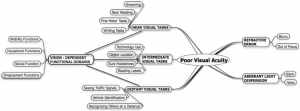A visual impairmentof any nature or magnitude, affects the ability of individuals to perform, safely and easily, important tasks in various functional areas. In fact, a visual impairment affects all of an individual's daily activities, such as walking, driving, housekeeping, school and work performance, financial and legal responsibilities, social interactions, leisure and recreational activities. The figure below illustrates the impact and relationships that a visual impairment has on the performance of visual tasks in different domains.
By M.J. Atkinson et al, 2013
Among visual impairments the presbyopia is an emmetropic, age-related condition that occurs when the lens loses its accommodative capacity and cannotTherefore, to focus images at close range. As the accommodative amplitude decreases, the influence of presbyopia on the quality of vision increases, at the same time negatively affecting the quality of life (QdV)
Presbyopia is a condition that affects all adult individuals, regardless of gender and area of origin, with consequences for lifestyle and societyDespite this, there is still a lack of data on the impact this condition has on quality of life.
The current treatments for presbyopia are corrective in nature with lenses (bifocals, trifocals or contact lenses) or surgical (intraocular lenses, laser or conventional corrective surgical techniques).
The most common method of correction is undoubtedly the use of the eyeglasses. However, studies to this effect suggest that even spectacle-corrected presbyopes suffer from significant reduction in their QdV compared to emmetropics.
Le low satisfaction rates with the use of reading glasses have promoted intensive research in the field of surgical correction of presbyopia. In recent decades, in fact, numerous techniques to eliminate dependence on spectacles and restore a true accommodative capacity of the eye. The laser refractive surgery can correct the most common visual defects by improving focus, but the real new frontier in correcting presbyopia is the replacement of the natural lens (crystalline lens) with a artificial intraocular lens (IOL) during cataract surgery. Innovations over the past decade, both in IOL design and surgical technique, have significantly improved visual performance, generally improving the patient's quality of life and satisfaction. Numerous presbyopes are now candidates for the latest generation of IOLs, especially among that segment of the population referred to as generation X (born between 1965-1980), consisting of managers and professionals who, working with computer media and travelling a lot, are unable to accept the effects of the loss of accommodative capacity and the use of spectacles. The surgical correction with intraocular lenses today represents a valid solution to improve the quality of life in terms not only of performing daily activities, but also of self-esteem and personal security.
Sources
-A qualitative investigation of visual tasks with which to assess distance-specific visual function. M.J. Atkinson et al. Qual Life Res (2013) 22:437-453.
-Review of the impact of presbyopia on quality of life in the developing and developed world. Ariana D. Goertz et al. Acta Ophthalmol. 2014: 92: 497-500.
-The quality of life associated with presbyopia. Luo BP, Brown GC, Luo SC & Brown MM (2008): Am J Ophthalmol 145: 618- 622.
-Priorities for Presbyopes: Maintain Comfort and Continuity. Pamela A. Lowe. Review of Optometry, august 2016.
Dr. Carmelo Chines
Direttore responsabile

